Part A: Determining the complete rate law
The order of reaction with respect to the iodate ion, m, must be determined for the following rate. It is assumed that the order of reaction with respect to the bisulfate is zero, thus n is zero.

Sample calculation done for the first C2 value and the first rate value
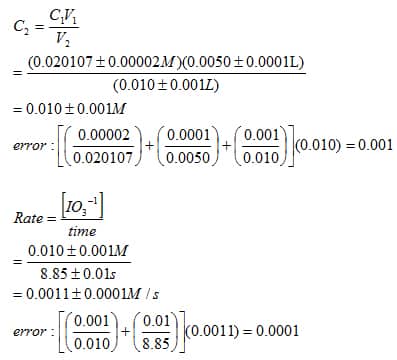
Table 1: Table containing C2 values
| VKlO3 (V1) | Vtotal(V2) | [IO3] (C2) | Time (s) | Rate (M/s) | |
| 1 | 0.0050(+/-)0.0001L | 0.010(+/-)0.001L | 0.010(+/-)0.001M | 8.85(+/-)0.01 | 0.0011(+/-)0.0001 |
| 2 | 0.0040(+/-)0.0001L | 0.010(+/-)0.001L | 0.008(+/-)0.001M | 9.87(+/-)0.01 | 0.0008(+/-)0.0001 |
| 3 | 0.0030(+/-)0.0001L | 0.010(+/-)0.001L | 0.006(+/-)0.001M | 13.05(+/-)0.01 | 0.0004(+/-)0.0001 |
| 4 | 0.0020(+/-)0.0001L | 0.010(+/-)0.001L | 0.004(+/-)0.001M | 19.50(+/-)0.01 | 0.0002(+/-)0.0001 |
| 5 | 0.0010(+/-)0.0001L | 0.010(+/-)0.001L | 0.002(+/-)0.001M | 52.58(+/-)0.01 | 0.00004(+/-)0.00002 |
Sample log calculation done for the first value of C2 and the first rate value
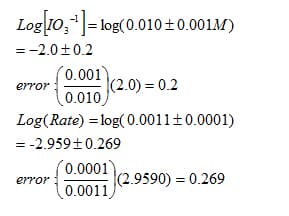
Table 2: contains the log[iodate ions] and the log(rate)
| [IO3] (C2) | Log[IO3] | Rate (M/s) | Log(Rate) | |
| 1 | 0.010(+/-)0.001M | -2.0(+/-)0.2 | 0.0011(+/-)0.0001 | -2.959(+/-)0.269 |
| 2 | 0.008(+/-)0.001M | -2.10(+/-)0.26 | 0.0008(+/-)0.0001 | -3.097(+/-)0.387 |
| 3 | 0.006(+/-)0.001M | -2.22(+/-)0.37 | 0.0004(+/-)0.0001 | -3.398(+/-)0.846 |
| 4 | 0.004(+/-)0.001M | -2.4(+/-)0.6 | 0.0002(+/-)0.0001 | -3.699(+/-)1.851 |
| 5 | 0.002(+/-)0.001M | -2.7(+/-)01.35 | 0.00004(+/-)0.00002 | -4.398(+/-)2.199 |
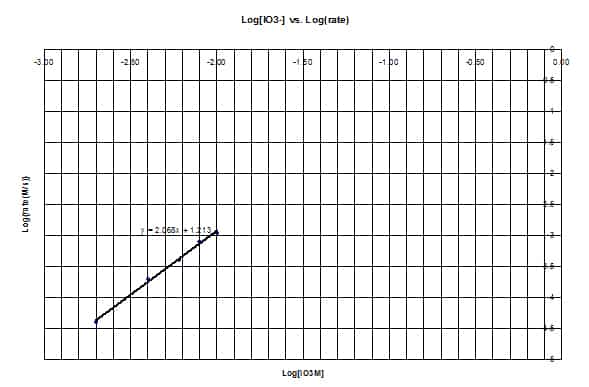
Equation of the line of best fit is y = 2.068x + 1.213
The slope represents the order of reaction with regards to the iodate, but the actual value is 2.0.

Thus, the percent error for the order of reaction with regards to the iodate is 3.4%.
The rate law now is:

Now to find the value of the rate constant, k
The sample calculation for 1/[IO3] is done for the first row of values

Table 3: Contains the 1/[IO3] values
| [IO3 M] C2 | 1/[IO3] | time (s) | |
| 1 | 0.010(+/-)0.001M | 100.0(+/-)10.0 | 8.85(+/-)0.01 |
| 2 | 0.008(+/-)0.001M | 125.0(+/-)15.6 | 9.87(+/-)0.01 |
| 3 | 0.006(+/-)0.001M | 166.7(+/-)27.8 | 13.05(+/-)0.01 |
| 4 | 0.004(+/-)0.001M | 250.0(+/-)62.5 | 19.50(+/-)0.01 |
| 5 | 0.002(+/-)0.001M | 500.0(+/-)250.0 | 52.58(+/-)0.01 |

The equation of the line is y = 8.8053x + 45.55
The slope of the line represents the value of the rate constant k, 8.8053.
Thus, the new rate is:

Part B: Find the Activation Energy
The sample calculation for 1/T done for the first row of values
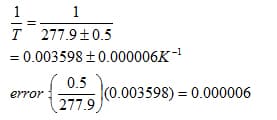
Table 4: Has the temperature and temperature reciprocal values
| Temperature (K) | 1/T (1/K) | |
| 1 | 277.9(+/-)0.5 | 0.003598(+/-)0.000006 |
| 2 | 283.1(+/-)0.5 | 0.003532(+/-)0.000006 |
| 3 | 289.2(+/-)0.5 | 0.003458(+/-)0.000006 |
| 4 | 298.0(+/-)0.5 | 0.003356(+/-)0.000006 |
| 5 | 303.5(+/-)0.5 | 0.003295(+/-)0.000005 |
| 6 | 305.0(+/-)0.5 | 0.003279(+/-)0.000005 |
Sample calculation done for Rate #1 (C1 value is the same for all calculations)

Table 5: The rate values for different temperatures
| Time #1 (s) | Rate #1 (M/s) | Time #2(s) | Rate #2 (M/s) | |
| 1 | 9.930 (+/-)01 | 0.0020250(+/-)000002 | 8.750(+/-)01 | 0.0022980(+/-)000003 |
| 2 | 8.350(+/-)01 | 0.0024080(+/-)000003 | 8.340(+/-)01 | 0.0024110(+/-)000003 |
| 3 | 7.440(+/-)01 | 0.0027030(+/-)000004 | 6.900(+/-)01 | 0.0029140(+/-)000004 |
| 4 | 6.080(+/-)01 | 0.0033070(+/-)000006 | 6.150(+/-)01 | 0.0032270(+/-)000006 |
| 5 | 5.220(+/-)01 | 0.0038520(+/-)000008 | 5.370(+/-)01 | 0.0037440(+/-)000008 |
| 6 | 4.360(+/-)01 | 0.004610(+/-)00001 | 4.270(+/-)01 | 0.004710(+/-)00001 |
Sample calculation for the rate constant, k for Rate #1 (Again C1 stays the same for all calculations)
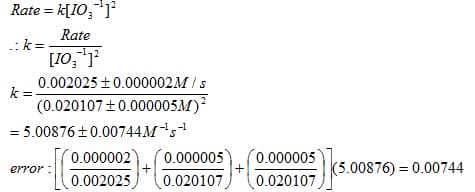
Table 6: shows the rate constants values at different temperatures
| K value #1(1/Mxs) | K value #2 (1/Mxs) | |
| 1 | 5.00876(+/-).00744 | 5.68402(+/-).01025 |
| 2 | 5.95610(+/-).01038 | 5.96352(+/-).01039 |
| 3 | 6.68577(+/-).01322 | 7.20767(+/-).01348 |
| 4 | 8.17974(+/-).01891 | 7.98187(+/-).01881 |
| 5 | 9.52778(+/-).02453 | 9.26065(+/-).02439 |
| 6 | 11.4027(+/-).03041 | 11.6500(+/-).0305 |
Sample calculation of the ln(k) using the k value #1 in the table above
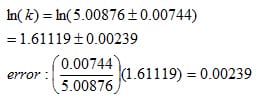
Table 7: shows the ln of the rate constants values at different temperatures
| lnk values #1 | lnk values #2 | |
| 1 | 1.61119(+/-).00239 | 1.73769(+/-)0.00313 |
| 2 | 1.784420(+/-).00311 | 1.78566(+/-)0.00311 |
| 3 | 1.89998(+/-)0.00376 | 1.97514(+/-)0.00369 |
| 4 | 2.10166(+/-)0.00486 | 2.07717(+/-)0.00489 |
| 5 | 2.25421(+/-)0.00581 | 2.22577(+/-)0.00586 |
| 6 | 2.43385(+/-)0.00649 | 2.45531(+/-)0.00643 |
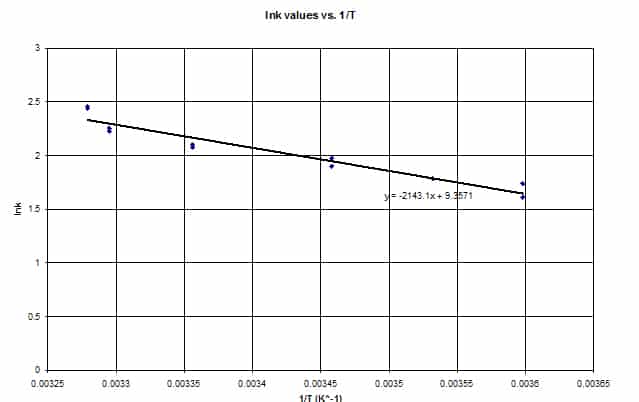
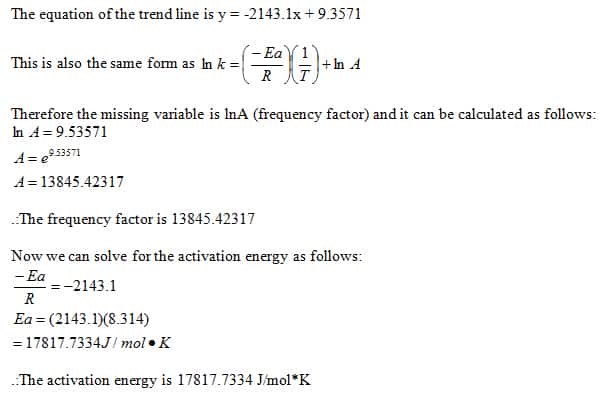
Conclusion & Evaluation
Conclusion
In conclusion, from part A the order of reaction of the iodate was found to be 2.068 while the actual value is 2, and the percent error for this value was 3.4 %. The final rate law determined was:

In part B the activation energy was found to be 17817.334 J/mol*K and the frequency factor is 13845.43317.
Conclusions that can be drawn from the data is that when the concentration of the potassium iodate solution was increased, the rate of reaction decreased. Another relationship that can be seen between the rate constant and the temperature is that as the temperature increased the rate constant increased as well.
All throughout the lab the assumption that is made throughout the lab is that the bisulfate ion has a reaction order of zero. This assumption will be further evaluated in the evaluation of the weaknesses and limitations.
Evaluation
A limitation in part A would have been that the stirring would have affected the time it took for the solution to turn blue. Some of the tubes may have gotten more stirred than others and this would have caused an inaccuracy in the times that were collected. Also, some solutions turned blue right away and others took a while so they could be seen by the human eye.
Better collection techniques such as spectrometry should have been used because then when ion changed color it would be detected right away. As well another way that the procedure can be improved upon is to perform the lab like a titration lab using a burette, flask, and indicator.
Also because the assumption was made that the reaction order of the bisulfate was zero because it was constant throughout may have affected the results as well. The experiment should have been done both ways to have the most accurate results. Instead of the iodate ion concentration being changed the concentration of the bisulfate could have been changed by making it the limiting reactant in the balanced equations.
Lastly, a limitation in part B is that a final temperature for the solution could not be measured because all of the surrounding influences such as holding the tube would have transferred heat to the solution.
Also, when the tube was taken out of the bathtub the room temperature immediately affected it, constantly changing the final reaction. Instead of this method, the experiment should have been done in the bathtub where it wouldn’t have been as much as affected by the surrounding temperatures.
